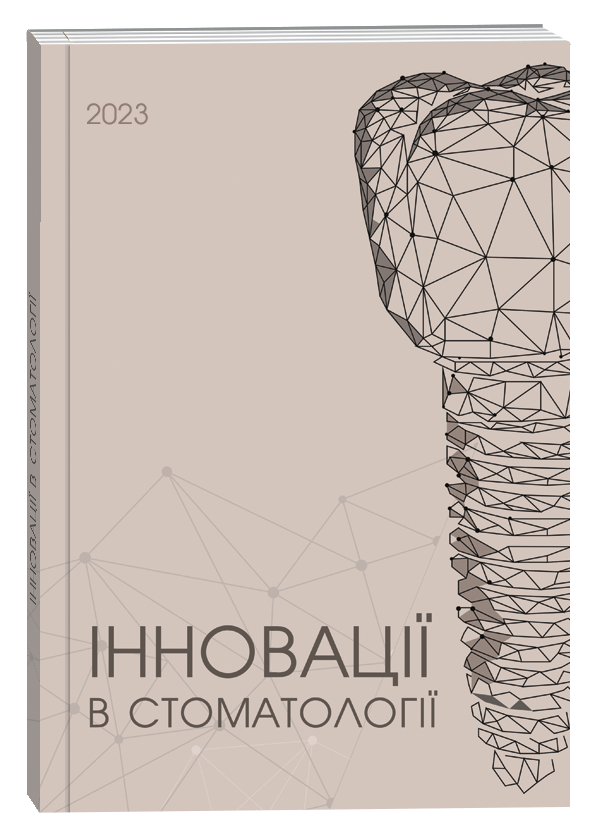COMPREHENSIVE MULTIDISCIPLINARY APPROACH TO THE TREATMENT OF PATIENTS WITH POLYODONTY, HYPERDONTY. CLINICAL CASES
DOI:
https://doi.org/10.35220/2523-420X/2025.2.16Keywords:
supernumerary teeth; stages of treatment; tooth extraction surgery; interdisciplinary approachAbstract
A supernumerary tooth may be single or multiple, unilateral or bilateral, and occur with varying frequency in different populations. Supernumerary teeth are classified by shape, morphology, location, and appearance. Additional diagnostic methods should be used. Purpose of the study. Analysis of treatment results of patients with supernumerary teeth. Materials and methods. Twenty-two patients with 86 supernumerary teeth, aged 20 to 26 years, were under clinical observation. The treatment consisted of removing supernumerary teeth. Digital data processing was performed according to standard methods using the Statistica 2018 program. Research results. Digital data analysis showed more supernumerary teeth on the lower jaw in women. The data obtained indicate that the dentist-orthodontist most often detected the presence of supernumerary teeth during examination. To some extent, this explains the greater number of women in our study: women consulted a dentist with complaints of incorrect tooth position. There were more supernumerary teeth on the lower jaw than on the upper jaw; in particular, the most significant number of supernumerary teeth was observed in the area of the molars of the lower jaw. All patients underwent removal of the supernumerary tooth after determining the stages of complex treatment. Indications for removal of the supernumerary tooth were: the presence of localized periodontitis in the area of the erupted tooth, and conservative treatment of localized periodontitis was unsuccessful. In the operated patients, wound healing occurred by both primary and secondary tension. In the presence of signs of a local inflammatory process, in 3 cases, the wound healed by secondary tension. For pain, patients were recommended nonsteroidal anti-inflammatory drugs. Clinical observations of operated patients confirm that the sooner the surgical intervention is performed, the sooner a successful orthodontic treatment result is achieved. Timely early diagnosis and interdisciplinary connections in the presence of supernumerary teeth can minimize the development of potential complications associated with this anomaly. Conclusions. Achieving a successful outcome is possible with a comprehensive approach to the sequence of interventions, determining indications for surgical treatment, the timing of its implementation, rehabilitation measures, and further management by doctors of related specialties.
References
Mallineni, Sreekanth & Nuvvula, Sivakumar. Management of supernumerary teeth in children: A narrative overview of published literature. Journal of Cranio-Maxillary Diseases. 2015. №4: 62-68. doi: 10.4103/2278-9588.151907.
Tworkowski, K., Gąsowska, E., Baryła, D., Gabiec, K. Supernumerary Teeth – Literature Review. J Pre Clin Clin Res. 2020. № 14(1): 18-21. https://doi.org/10.26444/jpccr/119037
Mallineni SK. Supernumerary teeth: review of the literature with recent updates. Conference Papers in Science. 2014. doi:10.1155/2014/764050
Ata-Ali F, Ata-Ali J, Peñarrocha-Oltra D, Peñarrocha-Diago M. Prevalence, etiology, diagnosis, treatment and complications of supernumerary teeth. J Clin Exp Dent. 2014. № 6(4): 414–418. https:// doi.org/10.4317/jced.51499
Saori Endo , Sugako Sanpei, Akiko Takakuwa, Keiko Takahashi, Toshiya Endo. Association of agenesis of mandibular lateral incisors with other dental anomalies in a Japanese population. J Dent Child (Chic). 2013. № 80(1):9-15.
Parolia A, Kundabala M, Dahal M, Mohan M, Thomas MS. Management of supernumerary teeth. J Conserv Dent. 2011. № 14(3):221-4. doi: 10.4103/0972-0707.85791. PMID: 22025821; PMCID: PMC3198547.
Sivakumar Nuvvula , M Kiranmayi, G Shilpa, S V S G Nirmala. Hypohyperdontia: Agenesis of three third molars and mandibular centrals associated with midline supernumerary tooth in mandible. Contemp Clin Dent. 2010. № 1(3):136-41. doi: 10.4103/0976-237X.72775.
Mariam Al-Abdallah , Abeer AlHadidi , Mohammad Hammad , Hazem Al-Ahmad , Raja' Saleh. Prevalence and distribution of dental anomalies: a comparison between maxillary and mandibular tooth agenesis. Am J Orthod Dentofacial Orthop. 2015. № 148(5):793-8. doi: 10.1016/j.ajodo.2015.05.024.
Subasioglu A, Savas S, Kucukyilmaz E, Kesim S, Yagci A, Dundar M. Genetic background of supernumerary teeth. Eur J Dent. 2015. № 9(1):153-158. doi: 10.4103/1305-7456.149670. PMID: 25713500; PMCID: PMC4319293.
Jain A, Taneja S. Bilateral presentation of different supernumerary teeth in nonsyndromic patients: case reports. Gen Dent. 2020. № 68(2):39-42.PMID: 32105225
Gurler G, Delilbasi C, Delilbasi E. Investigation of impacted supernumerary teeth: a cone beam computed tomography (CBCT) study. J Istanb Univ Fac Dent. 2017. № 51(3): 18–24. https://doi.org/10.17096/ jiufd.20098
Seehra J, Mortaja K, Wazwaz F, Papageorgiou SN, Newton JT, Cobourne MT. Interventions to facilitate the successful eruption of impacted maxillary incisor teeth due to the presence of a supernumerary: A systematic review and meta-analysis. Am J Orthod Dentofacial Orthop. 2023. № 163(5):594-608. doi: 10.1016/j.ajodo.2023.01.004. Epub 2023 Mar 11. PMID: 36907703.
Meade Maurice. Supernumerary Teeth: an Overview for the General Dental Practitioner. Dental update. 2020. № 47: 729-38. 10.12968/denu.2020.47.9.729.
Фетісов В.С. Пакет статистичного аналізу даних STATISTICA : навч. посіб. / В.С. Фетісов. Ніжин : НДУ ім. М. Гоголя, 2018. 114 с.








